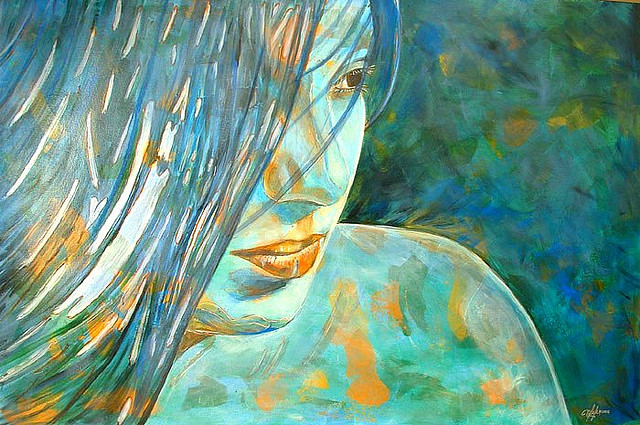Somewhere in the mists of time, a goddess roamed the woods and fields of the Old World, celebrated widely for her essential life-giving presence.
Her consort was the Lord of the Forest, sometimes portrayed as the stag, a powerful and virile energy who served as steward of the land and its non-human denizens.
Together the Divine Feminine and the Sacred Masculine embodied the union of opposites and the whole of creation—the creative masculine spark seeding the feminine womb of possibility.
Banished—vilified, even—from Europe’s Middle Ages onward, the Divine Feminine seems to have recently made a rather significant reappearance in the world. In a timely swing away from notions of a patriarchal version of God the Father, women in particular are embracing the Goddess in many forms and along a wide array of avenues.
“Whether we call her the Goddess, Gaia, God as Mother, the Divine Feminine, the Black Madonna, Tara, Kuan Yin, the Bodhisattva, the Dark Mother, Oshun, Sophia, Wisdom, the Tao, Mary, Kali or the Lady of Guadalupe, she is making a much-needed and much heralded return. Indeed, not since the twelfth century has the Goddess been so active in Western Culture.
What good is it if the goddess returns and men refuse her presence?
What good is it if the goddess strives to blossom in both women and men, but men offer her no home?
What good is it if Sophia wakes up women but not men?
This will not do—not in personal relationships and not in cultural institutions, all of which need a healthy gender balance of masculine and feminine, male and female, yin and yang.” (excerpted from The Hidden Spirituality of Men, by Matthew Fox)
Despite her reappearance, her consort remains absent, the one whose role is to praise, uphold, protect and make love to her. He who celebrates her as different but equal, the brave steward who appreciates the interrelatedness of all life.
The world remains gripped in greedy hands of an adolescent, one-dimensional masculinity, and something essential remains missing.
Where, and who, is the Sacred Masculine of our times?
Our smaller, daily lives are woven within the larger story. Whether we call her the Goddess or the Divine Feminine, she exists in every woman, just as the Sacred Masculine—or at least the potential for that balancing energy—resides in each man.
The concept of a Sacred Masculine can be difficult. We confuse “sacred” with “religious,” which triggers a knee-jerk response (especially among the intellectuals). For some, the concept of a the Sacred Masculine conjures up the patriarchal Old Man in the Sky, which depending on your perspective is either a good association or a distressing one.
For others, the concept of a sacred masculinity seems a bit mushy, saccharine, or embarrassingly spiritual.
Personally, I would like to wrestle the idea away from religion and the New Age, instead embodying it with a different association and energy. Sacred need not mean religious. Like love, it can be that which kindles a flame in the heart and soul, illuminating something larger.
If we considered the Sacred Masculine as a heart-centered one, a different picture emerges.
In other writings, I have offered that one of the hallmarks of the Sacred Masculine is that it embodies a heart-centered masculinity. Relational. Understanding—celebrating, even—that all life is interconnected and everything is relationship.
The Sacred Masculine is also characterized by the appropriate use of personal power, the ability to feel deeply, and stewardship that upholds our collective interrelatedness—human and other.
In our rush towards all things modern, disposable and convenient, we have lost much of what once sustained us. A sense of manners is crumbling away too. In an age shorn of mystery, what would it mean for men to court to Divine Feminine?
A slightly old fashioned energy exists in “courting;” it’s different than dating, and it couldn’t be farther from a one-night stand. It carries a quality of gradually winning favor from the desired one, of somehow proving one’s worthiness over time, with the further intention of marriage.
I have written elsewhere that by their very nature, the so-called feminine traits are more attuned to relationship, process, and harmony. For men, as we cultivate these relational qualities, we then enhance our ability for resonance, feeling, cooperation and intimacy…and wholeness.
To court the Divine Feminine requires being a worthy candidate. It is to become a vocal celebrant of beauty. It means valuing a more receptive and inwards orientation, an openness and inviting of cooperation rather than competition. It is to honor intuition and become aware of what is present (though perhaps not always seen or named).
We must be vulnerable and relational, not guarded and apart.
I wonder, are we brave enough as men to admit that the Divine Feminine exists not just “out there” but also “in here”?
For balance to exist, these archetypal energies must exist in a sacred union. They are two equal parts of a whole—even within ourselves, no matter our respective gender or that of our beloved.
What the world needs is a man’s compassionate heart, one that realizes he is only half the equation, and that unity and balance come from welcoming the Divine Feminine specifically for those differences.
All the creative intelligence of the universe—the union of the Divine Feminine and Sacred Masculine—is reflected in our lover’s eyes.
Men, it’s time to take off your armor. You cannot court mystery or the Divine Feminine while wearing it. Armor is for war, not lovemaking. And though the Goddess in every woman or man appreciates strength, she values it most when it is bravely undefended and vulnerable—in resonance with her own heart and the soul of the world.
The Divine Feminine is making her return. She awaits a worthy consort, one that has been too long missing. We must each discover, reclaim and embody the Sacred Masculine.
I say that as conscious, evolving men we can do more than than court the Divine Feminine. Both within and outside ourselves, let us champion and celebrate the holy union of opposites.
Relephant:
The Sacred Masculine.
Author: L. R. Heartsong
Editor: Renée Picard
Photo: Javier Avellan Veloz at Flickr












Read 2 comments and reply